source(google.com.pk)
Traditional Dress Of France Biography
Traditional French Clothing
While a lot of foreigners imagine striped shirts, a knotted scarf and berets as a "traditional" French outfit, the reality is as varied as any other Western culture. Although regional clothing (like the headdress and embroidered dress of the Alsace region) is no more, fashion remains a tradition.
High fashion began in 1715, when ladies from the court gathered a group of tailors and designers, and plotted out new, custom-made fashions on the spot. Voilá: couture (garments made for a specific person) was created [source: DeJean].
Charles Worth, an American émigré, created haute couture (fashion houses) in the late 1800s by staging fashion shows and sewing labels into his pieces. By the 20th century, the bustle and corset disappeared, and French women took to loose-fitting undergarments and the sleek look of art deco infiltrated French fashion.
This paved the way for Coco Chanel's more austere and functional look, fitting for the period after World War I. Knockoffs became standard, and mass production began to take hold.
French fashion took a signature turn into an emergent art genre called "surrealism" (a movement marked by absurdity and juxtaposition) between the wars. Designers made hats that looked like shoes and evening dresses printed with not entirely elegant giant lobsters.
These bizarre (and not terribly utilitarian) looks continue in haute couture today. Lady Gaga, for one, should be grateful to the French for their foresight whenever she pulls her meat dress out of the hamper.
The beret illustrates how French fashion follows culture quite closely. Originally used by the sheep herding Basques of France and Spain, it was co-opted by intellectuals who embraced the common-man aesthetic of the hat. Soon, we all had to have one.
"Urbanization ruined everything," says Bernard Fargues, who makes berets in France, in an interview with The Telegraph. "At first when rural people moved into the cities, they carried on wearing the beret. And the intellectuals began to wear it as a symbol of solidarity ... But then people stopped wearing berets in the towns because it came to be seen as a sign of a provincial, a peasant. Beret wearing declined in proportion to the rural exodus" [source: Broughton].
France Traditional Clothes
Fashion has been an important industry and cultural export of France since the 17th century, and modern "haute couture" originated in Paris in the 1860s. Today, Paris, along with London, Milan, and New York City, is considered one of the world's fashion capitals, and the city is home or headquarters to many of the premier fashion houses. The expression Haute couture is, in France, legally protected name, guaranteeing certain quality standards.
The association of France with fashion and style (French: la mode) dates largely to the reign of Louis XIV when the luxury goods industries in France came increasingly under royal control and the French royal court became, arguably, the arbiter of taste and style in Europe. But France renewed its dominance of the high fashion (French: couture or haute couture) industry in the years 1860–1960 through the establishing of the great couturier houses such as Chanel, Dior, and Givenchy.
In the 1960s, the elitist "Haute couture" came under criticism from France's youth culture. In 1966, the designer Yves Saint Laurent broke with established Haute Couture norms by launching a prêt-à-porter ("ready to wear") line and expanding French fashion into mass manufacturing. With a greater focus on marketing and manufacturing, new trends were established by Sonia Rykiel, Thierry Mugler, Claude Montana, Jean-Paul Gaultier and Christian Lacroix in the 1970s and 1980s. The 1990s saw a conglomeration of many French couture houses under luxury giants and multinationals such as LVMH.


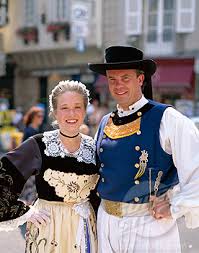
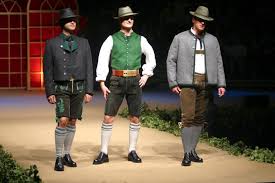
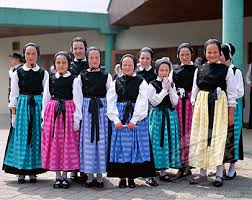
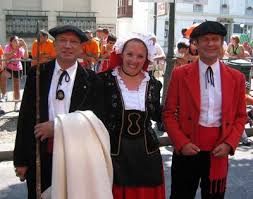


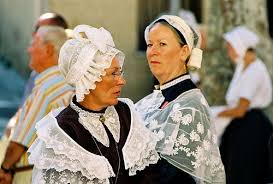

Traditional Dress Of France Biography
Traditional French Clothing
While a lot of foreigners imagine striped shirts, a knotted scarf and berets as a "traditional" French outfit, the reality is as varied as any other Western culture. Although regional clothing (like the headdress and embroidered dress of the Alsace region) is no more, fashion remains a tradition.
High fashion began in 1715, when ladies from the court gathered a group of tailors and designers, and plotted out new, custom-made fashions on the spot. Voilá: couture (garments made for a specific person) was created [source: DeJean].
Charles Worth, an American émigré, created haute couture (fashion houses) in the late 1800s by staging fashion shows and sewing labels into his pieces. By the 20th century, the bustle and corset disappeared, and French women took to loose-fitting undergarments and the sleek look of art deco infiltrated French fashion.
This paved the way for Coco Chanel's more austere and functional look, fitting for the period after World War I. Knockoffs became standard, and mass production began to take hold.
French fashion took a signature turn into an emergent art genre called "surrealism" (a movement marked by absurdity and juxtaposition) between the wars. Designers made hats that looked like shoes and evening dresses printed with not entirely elegant giant lobsters.
These bizarre (and not terribly utilitarian) looks continue in haute couture today. Lady Gaga, for one, should be grateful to the French for their foresight whenever she pulls her meat dress out of the hamper.
The beret illustrates how French fashion follows culture quite closely. Originally used by the sheep herding Basques of France and Spain, it was co-opted by intellectuals who embraced the common-man aesthetic of the hat. Soon, we all had to have one.
"Urbanization ruined everything," says Bernard Fargues, who makes berets in France, in an interview with The Telegraph. "At first when rural people moved into the cities, they carried on wearing the beret. And the intellectuals began to wear it as a symbol of solidarity ... But then people stopped wearing berets in the towns because it came to be seen as a sign of a provincial, a peasant. Beret wearing declined in proportion to the rural exodus" [source: Broughton].
France Traditional Clothes
Fashion has been an important industry and cultural export of France since the 17th century, and modern "haute couture" originated in Paris in the 1860s. Today, Paris, along with London, Milan, and New York City, is considered one of the world's fashion capitals, and the city is home or headquarters to many of the premier fashion houses. The expression Haute couture is, in France, legally protected name, guaranteeing certain quality standards.
The association of France with fashion and style (French: la mode) dates largely to the reign of Louis XIV when the luxury goods industries in France came increasingly under royal control and the French royal court became, arguably, the arbiter of taste and style in Europe. But France renewed its dominance of the high fashion (French: couture or haute couture) industry in the years 1860–1960 through the establishing of the great couturier houses such as Chanel, Dior, and Givenchy.
In the 1960s, the elitist "Haute couture" came under criticism from France's youth culture. In 1966, the designer Yves Saint Laurent broke with established Haute Couture norms by launching a prêt-à-porter ("ready to wear") line and expanding French fashion into mass manufacturing. With a greater focus on marketing and manufacturing, new trends were established by Sonia Rykiel, Thierry Mugler, Claude Montana, Jean-Paul Gaultier and Christian Lacroix in the 1970s and 1980s. The 1990s saw a conglomeration of many French couture houses under luxury giants and multinationals such as LVMH.
Traditional Dress Of France
Traditional Dress Of France
Traditional Dress Of France
Traditional Dress Of France
Traditional Dress Of France
Traditional Dress Of France
Traditional Dress Of France
Traditional Dress Of France
Traditional Dress Of France
Traditional Dress Of France
Traditional Dress Of France
No comments:
Post a Comment